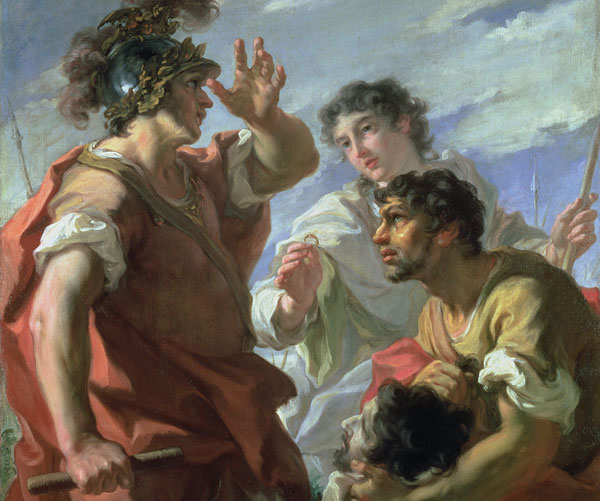Ctruth
"Seeking the Truth about Chronology Today"
Dependent Emperors and Events of the Second and Third Roman Empires


This article contains information which is based upon what is found in Chapter 2.1.2 of A. T. Fomenko’s ‘Empirico-Statistical Analysis of Narrative Materials and its Applications to Historical Dating’ Volume 2.
The 1st-3rd Roman Empires are defined in Fomenko’s work for the traditional dates as follows;
First Roman Empire – founded by Romulus and Remus c. 753 BC, ends with Tarquinius the Proud c. 509 BC
Second Roman Empire – founded by Lucius Sulla in 83-82BC, ends under Caracalla in 217 AD
Third Empire – founded by Lucius Aurelian in 270 AD, ends under Theodoric of the Ostrogoths in 526 AD
Fomenko makes note that he discovered differing optimal jets than [13] – N. A. Morozov, ‘Christ’, vols. 1-7 Gosizdat, Moscow-Leningrad, 1926-1932 (in Russian). In other words, the optimal jets are different than Morozov’s.
Fomenko reports that the first three emperors in the Second Empire (Sulla, Pompey, and Caesar) are traditionally regarded as “fictitious”.
What follows is Fomenko’s complete list of the emperors and events of the Second and Third Roman Empires “duplicates”;
1 – Lucius Sulla (82-78 BC) = Lucius Aurelian (270-275 AD)
2 – Confusion (78-77 BC) = confusion (275-276 AD)
3 – Marius Quintus Sertorius (78-72 BC) = Probus (276-282 AD)
4 – Confusion (72-71 BC) = confusion (282-284 AD)
5 – Gneeus Pompey the Great (70-49 BC) = Diocletian (284-305 AD)
6 – Co-rule of Pompey and Julius Caesar, First Triumvirate (60-49 BC) = co-rule of Diocletian and Constantius I Chlorus, First Tetrarch (293-305 AD)
7 – Confusion (49-45 BC) = confusion (305-309 AD)
8 – Julius Caesar, winner of First Triumvirate (45-44 BC) = Constantius I Chorus, winner of First Tetrarchy (305-306, or 293-306)
9 – Triumvirate (44-27 BC) = Tetrarchy (306-324 AD)
10 – Gaius Julius Caesar Octavianus Augustus, winner of Second Triumvirate (27 BC-14 AD, or 23 BC-14 AD) = Gaius Flavius Valerius Constantius Augustus, winner of Second Tetrarchy (306-337 AD, or 313-337 AD, or 324-337 AD)
10* – Birth of Jesus Christ in the year 27 since Augustus = birth of Basil the Great in the year 27 since Constantine I
11 – Tiberius Claudius Nero (14-37 AD) = Constantius II (337-361 AD, or 340-361 AD)
12 – Struggle between Tiberius and Germanicus (6-19 AD) = struggle between Constantius II and Constans (337-350 AD)
13 – Gaius Caesar Caligula (37-41 AD) = Caesar Julian (361-363 AD)
14 – Confusion after Caligula’s death (41 AD) = confusion after Julian’s death (363 AD)
15 – Claudius (41-54 AD) = Valentinian I (364-375 AD)
16 – “Co-rule” of Claudius and Pallas within the “Triumvirate” of Claudius, Pallas, and Narcissus (41-54 AD) = co-rule of Valentinian I and Valens within the “Triumvirate” of Valentinian I, Valens, and Gratian (367-375)
17 – Tiberius Claudius Nero (54-68 AD) = Valens (364-378 AD)
18 – “Co-rule” of Nero, Burrus, and Seneca (54-62 AD) = co-rule of Valens, Valentinian I, and Gratian (364-375 AD)
19 – “Co-rule” of Nero and Seneca (54-65 AD) = co-rule of Valens and Gratian (367-378 AD)
20 – Servius Sulpicius Galba (68-69 AD) = Jovian (363-364 AD)
21 – Confusion (69 AD) = confusion (378 AD)
22 – Two emperors named Titus Flavius Vespasian (69-81 AD) = Gratian, Valentinian II after Valens’ death (379-392 AD)
23 – Titus Flavius Domitian (81-96 AD) = Theodosius the Great (379-395 AD)
24 – Marcus Cocceus Nerva (96-98 AD) = Eugenius (392-394 AD)
25 – Co-rule of Nerva (96-98 AD) = co-rule of Eugenius (392-394 AD)
26 – Marcus Ulpius Trajan (98-117 AD, or 101-117 AD) = Arcadius (395-408 AD)
27 – Publius Aelius Hadrian (117-138) = Honorius (395-423 AD)
28 – Titus Aurelius Antoninus Pius (138-161 AD) = Aetius (423-444 AD, or 423-438 AD)
29 – Marcus Aurelius (161-180 AD) = Valentinian III (437-455 AD, or 444-455 AD, or 423-455 AD)
30 – Marcus Aurelius Commodus Antoninus (176-192 AD, or 180-192 AD) = Ricimer (456-472 AD)
31 – Publius Helvius Pertinax (193 AD) = Olybrius (472 AD)
32 – Marcus Didius Severus Julianus (193 AD) = Glyverius (473-474 AD)
33 – Decimus Clodius Albinus (193 AD) = Julius Nepos (474 AD)
34 – Gaius Pescennius Niger (193-194 AD) = Romulus Augustulus (475-476 AD)
35 – Lucius Septimius Severus (193-211 AD) = Odoacer (476-493 AD)
36 – Marcus Aurelius Antoninus Caracalla (193-217 AD, or 211-217 AD) = Theodoric the Great (497-526 AD, or 493-526 AD)
~~~~~
The following information is found after the list in the primary source for this article.
There is a discrepancy of 43 years between the Second Empire’s 299 year duration and the Third Empire’s 256 year duration which Fomenko stresses the importance of addressing. He takes note that no “massive” co-rules exist in the Second Kingdom while four “massive” co-rules exist in the Third Kingdom. I believe he is arguing that the 43 years are accounted for when moving the co-rulers into a consecutive count instead of counting together as parallel rule. I suggest reading the primary content to decide for yourself.
Given the parallelisms he discovered, he developed the hypotheses that the two empires’ stories were dependent with each other. That is to say that they may have been based upon one another or a common source document. His chapter part here does not aim to establish if one is based on the other or a third original, but to establish what the parallelisms are.
Fomenko cites four sources for the Third Roman Empire in one part of 2.1.2 of his book.
[74] = “J. Blair, ‘Blair’s Chronological and Historical Tables from the Creation to the Present Time etc.’, G. Bell & Sons, London, 1882.”
[128] = “V. S. Sergeev, ‘Essays on the History of Ancient Rome’, Sotsekgiz, Moscow, 1938 (in Russian).”
[134] = “‘History of Ancient Rome’, ed. A. G. Bokshchanin and V. I. Kuzishchin, Moscow, 1971 (in Russian).”
[146] = “B. Niese, ‘Grundriss der römischen Geschichte nebst Quellenkunde’, München, 1923.”
Emperors from the Third Empire which are known to us only through coins who ruled for less than a year in lands such as Gaul and Africa were not included.
With the above information considered, there is a 93% match.
Fomenko’s 2.1.2 ends with comments which lead into 2.1.3. These comments are about the specific similarities in the biographies. These specifics will be covered in the next article.
~~~~~ ~~~~~ ~~~~~ ~~~~~

References;
(1) – http://chronologia.org/en/kw2.pdf
~~~~~ ~~~~~ ~~~~~ ~~~~~
Do you like the article? Do you want access to more content?
You can get exclusive ChronologyTruth content on Patreon for as low as $1 a month
Become a ChronologyTruth Patron @ https://www.patreon.com/join/2402902?
~~~~~ ~~~~~ ~~~~~ ~~~~~

